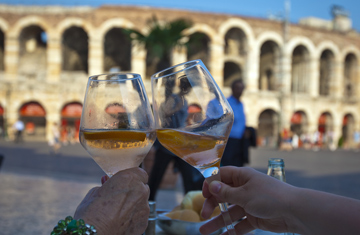
Two glasses of Prosecco with Aperol at the Piazza Bra in front of the Arena of Verona
When you pop a cork this holiday season, there's a good chance that the bubbles in your glass won't be French. Hard times, it turns out, can sometimes be good times — especially if you're a producer of Italian sparkling wine, or spumante. While the recession has taken some of the fizz out of France's champagne industry, in Italy, the bottles of bubbly have been flying off the shelves.
According to the Italian farmers' association Coldiretti, exports of spumante jumped 22% in the first half of 2010 — much of that thanks to demand from the U.S. — following a year in which Italian growers outproduced the French region of Champagne for the first time. Even as winemakers in France cut their number of bottles by 44% in 2009 in the face of slumping sales, exports from Italy surpassed domestic consumption.
Italy's main competitive advantage, so far, has been price. The bulk of the country's sales come from prosecco, a relatively cheap sparkling wine, easy to produce and often of low quality. While a bottle of Dom Perignon will ring in at well over $100, after having spent years in the cellar, a good prosecco takes just a few months to move from vine to wineglass and rarely costs more than $15. Some cheaper brands — suitable for mixing into cocktails — can run for much less. "The price is fundamental," says Giuseppe Carrus, a sommelier and co-editor of the Gambero Rosso guide to Italian sparkling wine. "Most people who drink prosecco aren't thinking about that particular drink from that particular region."
Now, however, some Italian winegrowers are trying to show they can take on champagne at its own game, producing upmarket bubblies from vineyards speckled across the foothills of the Alps. Northern Italy's mountain climate — crucial for producing a quality wine — approximates that of the Champagne region some 500 miles to the northwest. "We're able to take advantage of the altitude," says Camilla Lunelli, head of communications for the family-run Cantine Ferrari, the largest spumante producer in the Trento region of Italy. "We're ready to compete with whatever's in the glass."
The problem for these producers isn't so much in achieving champagne-level offerings. They've already done that. "We no longer have to say we're coming close to French champagne," says Antonino Cannavacciuolo, chef at the Villa Crespi Restaurant in the Italian region of Piedmont. "Today, there are producers who are making wine at the same level or, in some cases, doing even better." Cantine Ferrari, for instance, produced its first sparkling wine in 1902, and appellations like Trento, Oltrepò Pavese, and Franciacorta have implemented strict production standards, along the lines of those followed when making champagne. "In terms of quality, we have everything in order," says Maurizio Zanella, president of the consortium for the promotion of Franciacorta.. "What we need to work on is getting the word out."
Indeed, the real challenge for producers of champagne-quality sparkling wine is how to piggy-back on the success of prosecco, which has popped the cork off of foreign markets, while distinguishing their high-quality offering from its cheaper cousin. One way to do that has been to introduce their drinks in upscale Italian restaurants as a top-notch dinner drink, affiliating their brands with one of the world's most popular cuisines. "It's the easiest place to enter," says Lunelli. "We want to be a symbol of the Italian lifestyle."
Perhaps more importantly, growers of Italian sparkling wine are working on distinguishing their product from champagne itself. Until the 1940s, when growers in Champagne took measures to protect the name, Italian growers simply called their product "champagne." They then used the term Méthode Champenoise, until French growers successfully convinced the European Union to put a stop to that in the 1990s.
Today, Italy's quality producers say they simply use the Metodo Classico, meaning that like champagne, their sparkling wine undergoes a secondary fermentation in the bottle. They've stopped trying to ape their French counterparts, and have focused instead on accentuating their diversity — selling their products not as direct competitors to the well-known bubbly, or even as an Italian alternative, but as distinct brands, part of Italy's cornucopia of high-end wines.
The result, says sommelier Carrus, is a growing reputation for Italian sparkling wines as a drink for connoisseurs. "Champagne, without taking anything away from anybody, is something the consumer has always known," he says. "I got married six months ago. In my canteen, I have 60 bottles of champagne. But for my wedding, I wanted something special. So I chose an Italian bubbly."
